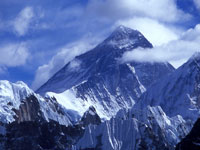U.S. artist turns Everest's trash into treasures
Hundreds of adventurers have been drawn to Mount Everest by the challenge of climbing to the top of the world. Jeff Clapp was drawn by the trash they leave behind.

Inspired by a documentary about Everest's rubbish, Clapp traveled to Nepal and brought a load of discarded oxygen bottles back in 2004.
He has created a business of transforming those banged-up, aluminum containers into gleaming bells, bowls and ornaments with a goal of inspiring people to do more to clean up the environment.
What began as a "madcap idea" is now called Bells from Everest. Clapp has sold 33 bells and bowls so far, and he and his wife have made 10,000 Christmas ornaments.
The trashing of Everest began even before Sir Edmund Hillary and Sherpa Tenzing Norgay first scaled the world's tallest mountain in 1953. Hillary acknowledged leaving behind oxygen bottles, food containers and torn tents in a pile near his base camp.
Like Hillary, virtually all hikers rely on oxygen because the air at Everest's summit has only one-third of the oxygen found at sea level. Over the years, hundreds of bottles piled up along with discarded climbing gear and other trash.
Recent efforts to clean up the mountain include a successful bounty program for oxygen bottles left behind. The Nepalese government now requires expeditions to pay deposits that are forfeited if rubbish is left behind.
Clapp, an artist, chef and concerned father, was inspired to go to Nepal by a National Geographic documentary about trash on Everest, which some called "the world's highest junkyard."
He obtained 132 cylinders from the Nepal Mountaineering Association for $7,000 (Ђ5,306). It cost nearly that much to ship them back to Maine.
Back at home in Brunswick, he works on the canisters in a basement workshop where the floor is littered with piles of aluminum shavings.
The hardest part, he said, is stripping away the yellow fiberglass shell to expose the darkened, oxidized aluminum underneath. He then uses hand tools to shape the bottles as they spin on a wood-turning lathe.
Eventually, they are buffed to a shiny silver color. Prices range from $1,600 (Ђ1,212.86)to $3,000 (Ђ2,274) for bells, and $500 (Ђ379) to $1,500 (Ђ1,137) for the bowls.
Nothing goes to waste. The shavings are put in glass balls to become $15 (Ђ11.37) Christmas ornaments that Clapp originally created as gifts for family members. They are sold at several locations, including the gift shop at Walt Disney World's Expedition Everest roller coaster, he said.
Clapp, said buyers like getting a unique piece of artwork and knowing that they're helping the environment at the same time. "They see the added value of purchasing a gift item that has social responsibility," he said.
When his supply of oxygen cylinders runs out, Clapp does not plan to retrieve any more of them. By the time he uses them up in a few years, he would like to return to Nepal to show locals how to create the bells to make money for themselves.
Clapp has had a preliminary discussion with Porters' Progress, an organization that works to improve the lives of the porters who carry equipment for Everest expeditions.
He said he hopes to line up corporate sponsors for the project, and to create a documentary. Eventually, he wants to write a book.
"My ultimate goal of returning this project to Nepal is very exciting to me. When I first visualized creating this artwork, I was driven with the concept that it would be a benefit to others, specifically in Nepal," he said
Subscribe to Pravda.Ru Telegram channel, Facebook, RSS!


